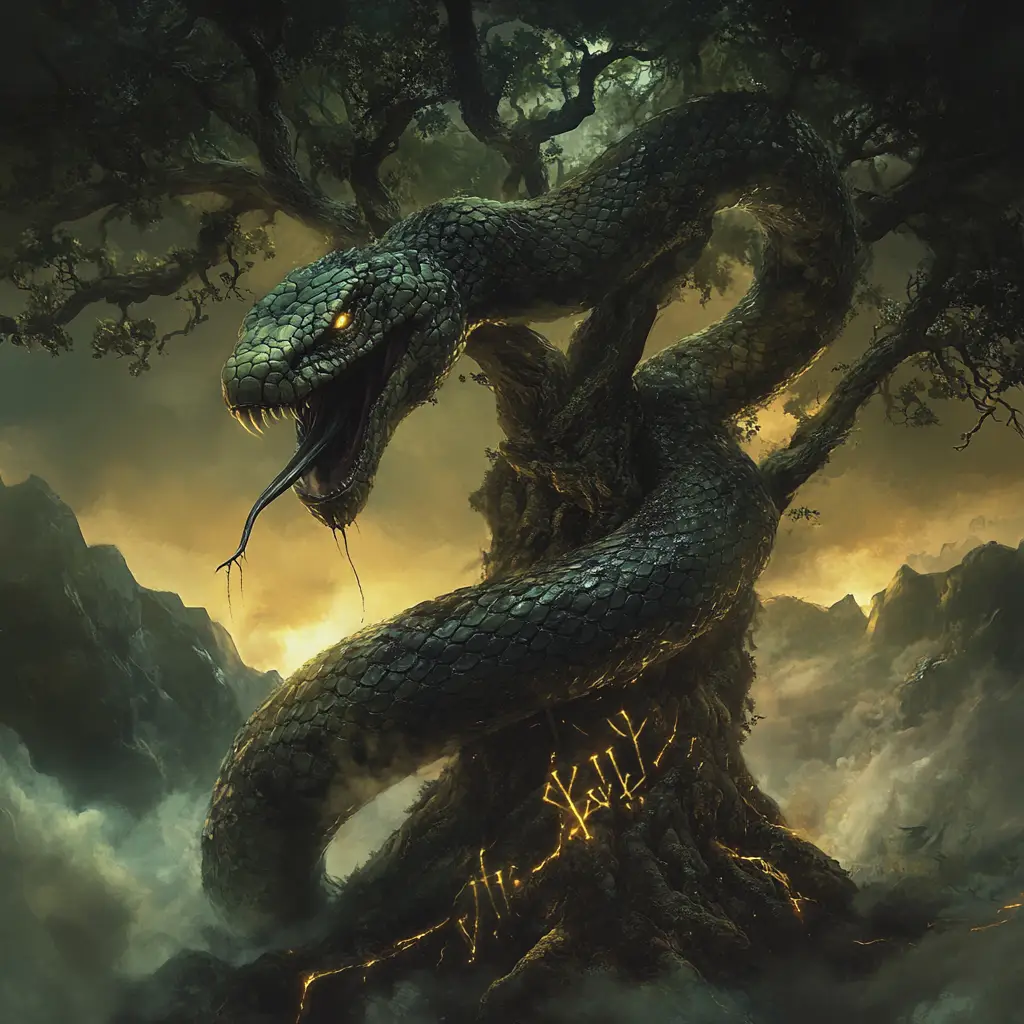Serpents play significant roles in Norse mythology, often symbolizing chaos, destruction, and the cyclical nature of life and death.
Serpents Physical Descriptions
Immense Size: Many serpents in Norse mythology are described as colossal, spanning great distances or encompassing entire realms. For example, Jörmungandr, the Midgard Serpent, is so large it encircles the Earth and bites its own tail.
Draconic Traits: Some serpents, like Fáfnir, are dragon-like, combining the serpentine body with additional features such as wings, scales, or the ability to breathe venom.
Venomous: Serpents are often associated with poison, as seen with Níðhöggr and the serpents of Náströnd, which torment their victims with venom.
Behavior and Actions
Cosmic Threats:
Serpents like Jörmungandr pose existential dangers, threatening the gods and the cosmos. Their actions often align with chaos and the destruction of order.
Níðhöggr undermines the cosmic balance by gnawing at Yggdrasil, symbolizing the slow decay of stability.
Punishers:
Some serpents are agents of punishment, such as the serpents of Náströnd, which torment sinners in the afterlife.
Greed and Corruption:
Fáfnir transforms into a monstrous serpent due to his overwhelming greed, highlighting serpents’ association with moral decay.
Catalysts of Change:
By initiating destruction or transformation, serpents contribute to the cycles of renewal in Norse cosmology, as seen in Ragnarok.
Symbolism
Chaos and Destruction: Serpents often embody the forces that threaten order, such as Jörmungandr’s venomous presence at Ragnarök.
Decay and Corruption: Níðhöggr’s constant gnawing at Yggdrasil symbolizes the inevitability of decay.
Cycles and Eternity: The ouroboros-like image of Jörmungandr biting its tail reflects themes of eternal cycles, linking destruction with renewal.
Transformation: Stories like Fáfnir’s highlight the transformative power of greed or ambition, turning even beings of order into agents of chaos.
Here are the most prominent serpents in Norse lore
Jörmungandr (The Midgard Serpent)
Role: Jörmungandr, the World Serpent, is one of Loki’s children with the giantess Angrboða. He is so large that he encircles the entire world (Midgard), biting his own tail.
Symbolism: Jörmungandr represents the concept of the ouroboros, symbolizing eternity, the cyclical nature of existence, and inevitable destruction.
Key Myth: At Ragnarok, Jörmungandr will battle Thor. Thor will kill the serpent, but he will succumb to its venom shortly afterward.
Níðhöggr
Role: Níðhöggr is the dragon or serpent that gnaws at the roots of Yggdrasil, the World Tree, seeking to destroy it.
Symbolism: He represents corruption, decay, and the inevitability of death.
Key Myth: Níðhöggr also feeds on the corpses of the wicked in Náströnd, a grim hall in Hel.
Fáfnir
Role: Although originally a dwarf, Fáfnir transforms into a dragon-like serpent after being consumed by greed and hoarding a cursed treasure.
Symbolism: Fáfnir embodies greed, transformation, and the destructive power of wealth.
Key Myth: Sigurd (Siegfried) slays Fáfnir in the Volsunga Saga, gaining wisdom from the serpent’s blood.
The Serpent of Gimlé
Role: Less commonly mentioned, this serpent is said to emerge after Ragnarok in some interpretations of the myth.
Symbolism: It may represent lingering chaos in a reborn world.
Other Mythical Serpents
Gnipahellir’s Guardian: A serpent associated with guarding Hel’s gate, though it is less defined in the myths.
Sea Serpents: Many Norse tales feature unnamed sea serpents as dangers to sailors, representing the untameable forces of nature.
In Norse cosmology, serpents often serve dual purposes: as destroyers and as agents of necessary transformation.
Serpents are essential to the Norse narrative, serving as antagonists and agents of cosmic balance. Their presence underscores the Norse belief in the inevitability of conflict and renewal in the natural and supernatural world.



